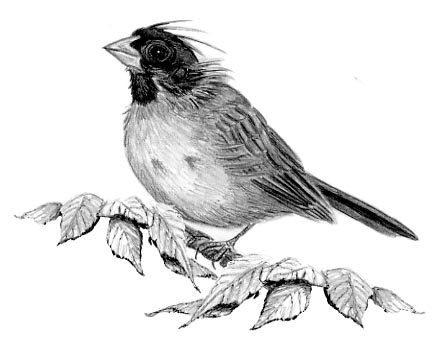
Mid-summer Assortment:
It’s the middle of the summer and this is the time of year when I seem to receive a lot of questions that I’ve already answered in past columns. But that’s okay, I don’t mind repeating myself. After all, who remembers anything anymore? However, instead of writing an entire column on each question, I’ve shortened my answers to just a single paragraph. In other words, the summer heat is making me lazy…or, as others might say, “lazier.”
Here’s my favorite summer topic:
Bald cardinals. In August we get swamped with reports of mysterious red birds or cardinals with jet-black heads. Some folks think they have found a new bird species, while others worry the birds have some sort of strange disease or have gotten too close to the Pilgrim power plant. The answer, of course, is that the birds are just going through their annual molt. Unlike humans, who have a closet full of fresh clothes to change into (or, in the case with my wife, several closets full of fresh clothes to change into), birds have to grow their fresh clothes. Usually, molting is such a slow, gradual process that it often goes unnoticed. But occasionally cardinals (and other birds) molt their head feathers rapidly, causing the birds to look like George Costanza. If you’ve never seen a bald cardinal, you should check it out on the Web. They are total freakaziods. Without their feathers, it’s surprising how tiny cardinals’ heads actually are. And with their giant red beaks, they look like pinheaded parrots. But not to worry; it won’t be long before their feathers will have grown back and they’ll be beautiful cardinals once again. The whole transformation only takes a few weeks, but if you don’t feel like waiting that long, adding a bit of Rogaine to your birdseed could help speed things up.
One of my favorite summer activities is when baby birds visit my backyard for the first time. The awkward youngsters land on my feeders, sometimes upside down, and try to figure out how to get to the food. With totally bewildered looks on their faces, they mistakenly peck at the feeder cover or at the screws that hold it together. This morning I watched a family of brand new Blue Jays. The young jays were quietly investigating my feeder until the adults arrived. At this point the kids sprang into begging mode, shaking and quivering their wings as if they had just stepped on a Taser.
Wing quivering makes it obvious which birds are the kids and which are the parents. But there is one bird that looks like an adult, even when its wings are shaking. I’m talking about the Brown-headed Cowbird. Cowbirds have figured out that if they lay their eggs in other birds’ nests, the host birds (which are often smaller) will frequently incubate and raise the cowbird babies as if they were their own. As a result, we see, for example, tiny adult Song Sparrows feeding much larger baby cowbirds. Experts feel that cowbirds evolved this odd child rearing strategy so they (the adult cowbirds) could lay their eggs and then continue to follow the massive buffalo herds that once dominated North America. The moving herds kicked up the insects that the birds fed on. Many birders don’t like cowbirds, but in my mind tricking someone else into raising your kids for you is a noble quality.
Remember back in June when I warned everyone that they would see fewer birds on their feeders? I explained that nesting season is a time when birds feed heavily on insects and ate much less seed. I was right, wasn’t I? Well, here’s another warning. Summer is meal moth season. Little brown moths that live and breed in grain and cereal products flourish in hot weather. Untreated grains, such as birdseed, often contain moth eggs that will hatch if not used right away. How do you know if you have meal moths? Your seed will become a webby clump, with white larvae crawling over it. (Lovely, eh?) My advice is to only buy the amount of seed you can use up in a few weeks. Resist the temptation to buy large quantities simply because you want to avoid the summer traffic or because the seed is on sale. And never, if you can possibly help it, store your seed in the house. Keep it in the garage or shed. It’s important to keep the moths away from people food. It’s not that the moths are poisonous, but if a summer guest happens to open your cookie jar and see moths fly out, it could be embarrassing (although funny).
Where are the hummingbirds and orioles? Back in May thousands of orioles and hummingbirds streamed across Cape Cod on their way north. These beautiful birds thrilled us when they visited our feeders. But by June many of them had either continued north or had settled into their local breeding territories. As a result, some folks saw fewer hummingbirds, or orioles or both. Well, don’t give up. As fall migration kicks into gear, the hummers and orioles will be passing through once again. So, make sure your feeders are clean and waiting for them. August is a good month to attract both orioles and hummingbirds one last time before they leave us for the winter.
One more thing about bald cardinals: Even though they look quite strange and a bit scary, you have to give the cardinals credit for accepting their baldness and not getting one of those stupid comb-overs. That fashion faux pas is reserved for misguided humans and certain presidential candidates.